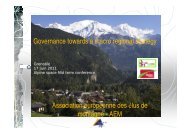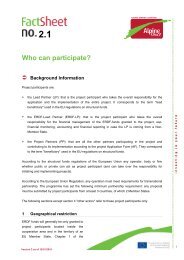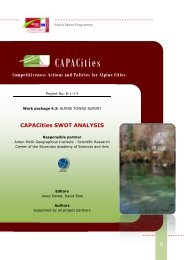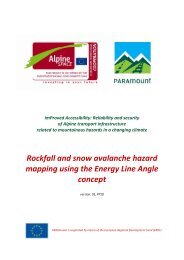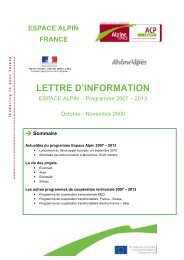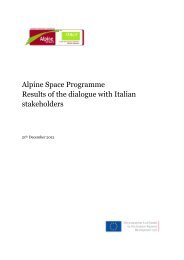the forest fire danger prediction for the alpine forest heritage ...
the forest fire danger prediction for the alpine forest heritage ...
the forest fire danger prediction for the alpine forest heritage ...
You also want an ePaper? Increase the reach of your titles
YUMPU automatically turns print PDFs into web optimized ePapers that Google loves.
Partner<br />
The project partners are 14 public institutions from Alpine Space regions: wea<strong>the</strong>r services, <strong>fire</strong> brigades,<br />
universities, regional/national authorities in charge of prevention, <strong><strong>for</strong>est</strong>ry services.<br />
Regional Agency <strong>for</strong> Environmental<br />
Protection of Piedmont (I)<br />
www.arpa.piemonte.it<br />
Regione Piemonte<br />
Forest Policy Dept. (I)<br />
www.regione.piemonte.it<br />
Regione Autonoma Friuli Venezia Giulia<br />
Regional Civil Protection (I)<br />
www.protezionecivile.fvg.it<br />
Regione Veneto - Directorate<br />
<strong>for</strong> Forest and Mountain Economy (I)<br />
www.regione.veneto.it<br />
Slovenian Forestry Institute (SI)<br />
www.gozdis.si<br />
Test and Research Center of <strong>the</strong> Entente<br />
<strong>for</strong> <strong>the</strong> Mediterranean Forest (F)<br />
www.valabre-ceren.org<br />
Central Institute <strong>for</strong> Meteorology<br />
and Geodynamics (AT)<br />
www.zamg.ac.at<br />
Regional Agency <strong>for</strong> Development<br />
of Agriculture and Forestry (I)<br />
www.ersaf.lombardia.it<br />
The <strong><strong>for</strong>est</strong> <strong>fire</strong> <strong>danger</strong> <strong>prediction</strong> <strong>for</strong><br />
<strong>the</strong> <strong>alpine</strong> <strong><strong>for</strong>est</strong> <strong>heritage</strong> conservancy<br />
Technical University of Munich,<br />
Institute of Ecoclimatology (D)<br />
https://portal.mytum.de/welcome<br />
University of Natural Resources and<br />
Applied Life Sciences, Department<br />
of Forest and Soil Sciences, Institute<br />
of Silviculture (AT) - www.boku.ac.at<br />
Sezione <strong><strong>for</strong>est</strong>ale cantonale,<br />
Divisione dell’ambiente, Dipartimento<br />
del Territorio, Cantone Ticino (CH)<br />
www.ti.ch/<strong><strong>for</strong>est</strong>ali<br />
Fire brigade federation<br />
of Canton Ticino (CH)<br />
www.pompieriticino.ch<br />
Swiss Federal Research Institute (CH)<br />
www.wsl.ch<br />
Regional development agency<br />
of Gorenjska region - BSC, Business<br />
support centre ltd. Kranj (SI)<br />
www.bsc-kranj.si<br />
Observers<br />
National Department <strong>for</strong> civil Protection (I)<br />
www.protezionecivile.it<br />
Global Fire Monitoring Center (D)<br />
www.<strong>fire</strong>.uni-freiburg.de<br />
Meteoswiss (CH),<br />
www.meteoschweiz.admin.ch/web/it/<br />
meteo.html<br />
Environmental Agency of Slovenia (SI)<br />
www.arso.gov.si<br />
Amt fur Wald Graubunden (CH)<br />
www.gr.ch<br />
Canton du Valais (CH)<br />
www.vs.ch<br />
Bavarian Ministry of Food,<br />
Agriculture and Forestry (D)<br />
www.lwf.bayern.de<br />
Préfecture Provence-Alpes-Côte d’Azur (F)<br />
www.paca.pref.gouv.fr<br />
Regione Lombardia (I)<br />
www.regione.lombardia.it<br />
Météo-France (F)<br />
www.meteo.fr<br />
Regione Autonoma Fiuli Venezia Giulia,<br />
Direzione centrale risorse agricole,<br />
naturali e <strong><strong>for</strong>est</strong>ali - www.regione.fvg.it<br />
Federal Office <strong>for</strong> <strong>the</strong> Environment (CH)<br />
www.bafu.admin.ch<br />
Local Partners<br />
Institute <strong>for</strong> <strong><strong>for</strong>est</strong>ry and environment (I)<br />
www.ipla.org<br />
Environmental Protection<br />
Regional Agency (I)<br />
www.arpalombardia.it<br />
University of Padua, Department of Land<br />
and Agro<strong><strong>for</strong>est</strong>ry Systems (I)<br />
www.tesaf.unipd.it<br />
Regional Agency <strong>for</strong> Environmental<br />
Protection and Prevention of <strong>the</strong> Veneto (I)<br />
www.arpa.veneto.it<br />
The ALP FFIRS project is co-funded by <strong>the</strong> EU INTERREG Alpine Space 2007-2013<br />
Programme under <strong>the</strong> priority 3 “Environment and risk prevention”<br />
Arpa Piemonte - Area Previsione e Monitoraggio Ambientale - Via Pio VII, 9 - 10135 Torino (I) - sc05@arpa.piemonte.it<br />
www.alpffirs.eu
The <strong>alpine</strong> <strong><strong>for</strong>est</strong> <strong>fire</strong>s<br />
During <strong>the</strong> last decades <strong>the</strong> frequency<br />
of <strong><strong>for</strong>est</strong> <strong>fire</strong>s showed a large increase:<br />
nearly 20.000 ha of Alpine <strong><strong>for</strong>est</strong>s, in addition<br />
to grasslands and non <strong><strong>for</strong>est</strong>ry areas,<br />
are burned each year. Forest <strong>fire</strong>s affect<br />
most of <strong>the</strong> <strong>alpine</strong> regions in Winter<br />
and early Spring, never<strong>the</strong>less frequency<br />
and burned area are increasing also in<br />
Summer, probably due to <strong>the</strong> global warming.<br />
At this stage <strong><strong>for</strong>est</strong> <strong>fire</strong>s are already<br />
threatening <strong>the</strong> <strong><strong>for</strong>est</strong> <strong>heritage</strong> of <strong>the</strong><br />
Alps. Forest <strong>fire</strong>s influence <strong>the</strong> vegetation<br />
composition and structure<br />
of any given location;<br />
<strong>fire</strong> shapes <strong>the</strong><br />
landscape and<br />
influences biogeochemical<br />
cycles such<br />
as <strong>the</strong> carbon<br />
cycle<br />
and soil<br />
processes.<br />
The impacts<br />
of<br />
<strong><strong>for</strong>est</strong> <strong>fire</strong>s<br />
affect <strong>the</strong> ecosystems<br />
severely<br />
by soil erosion as<br />
possible trigger <strong>for</strong> landslides<br />
and loss of soil fertility.<br />
The effects on biodiversity, human safety<br />
and mountain economy play an important<br />
role in rural development.<br />
The social and economic expenditures<br />
of dealing with sprouted <strong>fire</strong>s in <strong>the</strong> <strong>alpine</strong><br />
regions are rapidly increasing and are not<br />
in accordance with a sustainabile development.<br />
In future <strong>the</strong> situation could get out of<br />
control caused by rising temperatures,<br />
more frequent and severe droughts and<br />
o<strong>the</strong>r wea<strong>the</strong>r extremes due to climate<br />
change. Fur<strong>the</strong>rmore <strong>the</strong> occurrence of<br />
<strong><strong>for</strong>est</strong> <strong>fire</strong>s will be intensified as a consequence<br />
of booming turism, overexploitation<br />
and mountain depopulation in <strong>the</strong><br />
Sou<strong>the</strong>rn Alps. There<strong>for</strong>e actions must<br />
have to be substantially enhanced.<br />
The ALP FFIRS<br />
objectives<br />
ce critical conditions, favourable to <strong><strong>for</strong>est</strong><br />
<strong>fire</strong> triggering and spreading.<br />
The system will provide actors involved<br />
in <strong><strong>for</strong>est</strong> <strong>fire</strong> prevention and suppression,<br />
as well as <strong>the</strong> general public, with enhanced<br />
and more accurate <strong>prediction</strong>s of<br />
<strong><strong>for</strong>est</strong> <strong>fire</strong> <strong>danger</strong>. Methodologically similar<br />
and standardised actions can thus be<br />
ensured, through cooperation between<br />
partners, such as preparedness plans.<br />
Project description<br />
The project aims to improve <strong><strong>for</strong>est</strong><br />
<strong>fire</strong> prevention under a changing climate<br />
in <strong>the</strong> Alpine Space, by creating a shared<br />
warning system based on wea<strong>the</strong>r conditions.<br />
The <strong>fire</strong> regime at any given location<br />
is <strong>the</strong> result of complex interactions<br />
between fuels, social issues, topography,<br />
ignitions and wea<strong>the</strong>r conditions.<br />
The analysis of <strong>fire</strong>s frequency and<br />
distribution will allow to model <strong><strong>for</strong>est</strong> <strong>fire</strong><br />
<strong>danger</strong> in <strong>the</strong> <strong>alpine</strong> region. The definition<br />
of a univocal Alpine Forest Fire Danger<br />
Project management<br />
Climate Change Impact<br />
• Meteorological dataset <strong>for</strong> <strong>the</strong> control period<br />
• Regional climate scenarios and common<br />
methodology <strong>for</strong> downscaling<br />
• Statistical study about climate change impact<br />
on <strong>alpine</strong> <strong>fire</strong>s by <strong>fire</strong> indices<br />
• Common methodology assess future impact to<br />
<strong><strong>for</strong>est</strong> <strong>fire</strong>s due to changes in: lightning, <strong><strong>for</strong>est</strong><br />
vegetation, snow cover, socio-economic patterns<br />
• Maps of potential soil erosion of burnt areas<br />
Procedures & Training<br />
The overall objective of <strong>the</strong> ALP FFIRS<br />
project is to control and reduce <strong>the</strong> <strong><strong>for</strong>est</strong><br />
<strong>fire</strong> hazard in <strong>the</strong> Alpine environment considerably,<br />
through prevention and mitigation<br />
actions. The project aims to develop<br />
a multi-referential innovative service that<br />
supports <strong><strong>for</strong>est</strong> <strong>fire</strong> management, above<br />
all in prevention activities and in <strong>the</strong> mitigation<br />
of <strong>the</strong> negative impacts on <strong>the</strong> Alpine<br />
<strong><strong>for</strong>est</strong>s.<br />
The ambitious goal of ALP FFIRS is to<br />
set up a framework <strong>for</strong> a common warning<br />
system <strong>for</strong> <strong><strong>for</strong>est</strong> <strong>fire</strong> <strong>danger</strong> rating<br />
in <strong>the</strong> whole Alpine region taking into account<br />
wea<strong>the</strong>r conditions and vegetation<br />
patterns.<br />
The decision support tool will consist<br />
of a daily <strong>fire</strong> <strong>danger</strong> level assessment<br />
and <strong>for</strong>ecast in order to identify in advan-<br />
Scale will support<br />
<strong>the</strong> interpretation<br />
of <strong>danger</strong><br />
thresholds as<br />
enhancement<br />
of emergency<br />
plans and operational<br />
procedures.<br />
Due to <strong>the</strong><br />
debate on climate<br />
change, <strong><strong>for</strong>est</strong> <strong>fire</strong>s<br />
as potential disturbance<br />
have become an<br />
issue in <strong>the</strong> Alpine region over<br />
<strong>the</strong> last decade.<br />
An Alpine network on <strong><strong>for</strong>est</strong> <strong>fire</strong> impact<br />
mitigation will be assembled reflecting<br />
common policies in risk prevention<br />
management, by fostering mutual aid in<br />
prevention, prepardeness and suppression<br />
procedures.<br />
Warning System Implementation<br />
• Unique shared Alpine Forest Fire Danger Scale<br />
• Common system <strong>for</strong> <strong><strong>for</strong>est</strong> <strong>fire</strong> <strong>danger</strong> rating and<br />
warning in <strong>the</strong> Alps, operated locally<br />
• Wea<strong>the</strong>r data/<strong>fire</strong> occurrence dataset,<br />
integrated climatological and <strong><strong>for</strong>est</strong>ry maps<br />
• Improve <strong>the</strong> monitoring of wea<strong>the</strong>r<br />
parameters required <strong>for</strong> <strong><strong>for</strong>est</strong> <strong>fire</strong> prevention<br />
• Methodological approach of spatially<br />
high resolution mapping of meteorological data sharing<br />
• Common protocol <strong>for</strong> alerting and operational procedures according to <strong>fire</strong> <strong>danger</strong> conditions<br />
• Mutual aid measures in vigilance and extinction<br />
• Recommendation paper <strong>for</strong> institutional bodies<br />
• Training of operative personnel<br />
• Procedures guideline <strong>for</strong> end users<br />
In<strong>for</strong>mation & Publicity



